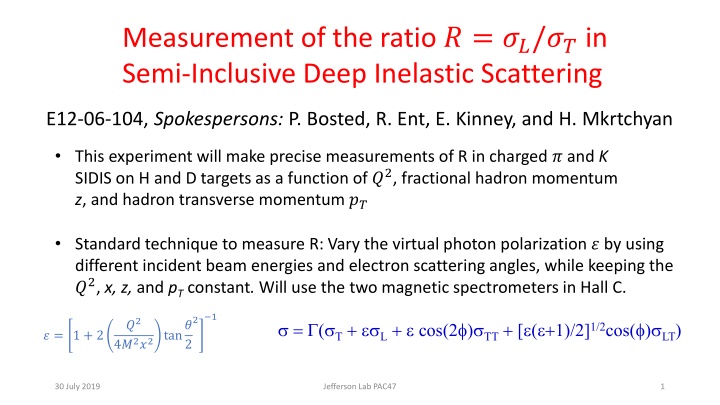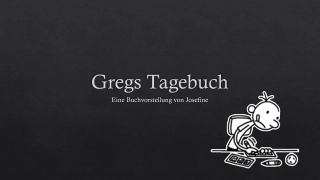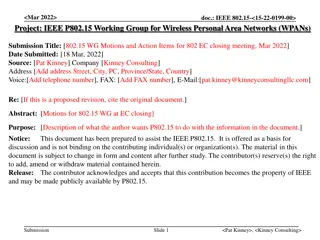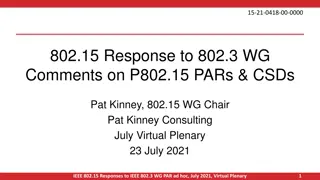
Precise Measurements of ??/?? Ratio in Semi-Inclusive DIS E12-06-104
Explore the experiment E12-06-104 aiming to measure the ??/?? ratio in Semi-Inclusive DIS. Learn about the methodology, significance, and potential outcomes of this essential measurement in photon-parton interaction research at Jefferson Lab.
Download Presentation

Please find below an Image/Link to download the presentation.
The content on the website is provided AS IS for your information and personal use only. It may not be sold, licensed, or shared on other websites without obtaining consent from the author. If you encounter any issues during the download, it is possible that the publisher has removed the file from their server.
You are allowed to download the files provided on this website for personal or commercial use, subject to the condition that they are used lawfully. All files are the property of their respective owners.
The content on the website is provided AS IS for your information and personal use only. It may not be sold, licensed, or shared on other websites without obtaining consent from the author.
E N D
Presentation Transcript
Measurement of the ratio ? = ??/?? in Semi-Inclusive Deep Inelastic Scattering E12-06-104, Spokespersons: P. Bosted, R. Ent, E. Kinney, and H. Mkrtchyan This experiment will make precise measurements of R in charged ? and K SIDIS on H and D targets as a function of ?2, fractional hadron momentum z, and hadron transverse momentum ?? Standard technique to measure R: Vary the virtual photon polarization ? by using different incident beam energies and electron scattering angles, while keeping the ?2, x, z, and pTconstant. Will use the two magnetic spectrometers in Hall C. 2 1 ?2 = ( + L + cos(2 ) TT + [ ( + )/2]1/2cos( ) LT) 4?2?2tan? ? = 1 + 2 2 30 July 2019 Jefferson Lab PAC47 1
? = ??/?? is a basic aspect of the photon-parton interaction First DIS evidence that quarks had spin (R 0 as ?2 ) 0.5 0.25 R 0 Almost no experimental knowledge of R in SIDIS 0.2 0.4 0.6 Z 0.8 1 0.5 0.25 Projections for E12-06-104 vs existing Cornell Data (projections assume RSIDIS = RDIS) Comparable 1.6% systematic uncertainties not indicated R 0 1 2 3 4 5 Q2 (GeV/c)2 Projections: Solid Black H, Open Black D ? Cornell: Top panel: solid red (open blue) ?+ (? ) on LH2 Middle : solid red (open blue) dots are ?+ (? ) on LH2 solid red (open blue) squares are ?+ (? ) on LD2 Bottom : solid red (open blue) dots are for ?+ (? ) on LH2 0.4 R 0.2 0 0 0.2 0.4 0.6 0.8 1 PT2 (GeV/c)2 30 July 2019 Jefferson Lab PAC47 2
An essential measurement in understanding SIDIS in LO factorized form at these energies ~ eq2q(x) Dq (z) quark Previous JLab cross section experiments experiments suggest this factorized picture is valid at JLab energies at appropriate final hadronic state energies We will be able to test many common assumptions used in SIDIS analyses: ??????= ????? ?+ = ?????? ? ?????? = ?????? ? ?+ ?+ ?+ ? ? ? ? ?????? = ?????? ?????? = ?????? ? ? ?????? Important for determining spin structure function g1h (need term 1 + ?? to get g1h/F1h from ? h) At low z, expect DIS Q2 behavior (~1/?2), but as z 1, expect Deep-Exclusive Q2 behavior (~?2) Completely unknown pT behavior, which might impact on TMD analyses 30 July 2019 Jefferson Lab PAC47 3
? = ??/?? in SIDIS PAC36 Report Very Positive E12-06-104 (RSIDIS): Measurement of the Ratio R = L/ T in Semi-Inclusive DIS This experiment will use the unique capabilities of JLab-12 to measure an observable that has been urgently needed for some time. Analyzers of all SIDIS data collected to date have had to resort to model-dependent guesses for the R ratio, typically using either zero or the values determined from inclusive DIS. As the proposal lucidly explains, RSIDISwill likely have a pronounced dependence on the z value of the measured hadron; its behaviour will help to shed light on the nature of the SIDIS process, which is particularly important at the rather modest energies of JLab where deviations from the LO factorized picture may be a significant element in the interpretation of the high-statistics SIDIS data to be collected at 12 GeV. The concern raised at PAC30 concerning the experiment s limited ability to constrain azimuthal moments of the SIDIS cross-section was acknowledged by PAC36 but felt not to constitute a significant impediment. It is an inescapable complication in this exploratory measurement, and the committee is confident that the experimenters will identify good strategies to address it once the first data are collected. Finally the committee would like to emphasize that the A rating does not reflect any doubt about the importance of this unique measurement, simply an honest guess that the results will likely confirm expectations and that their impact will be limited by the technical nature of the subject. Rating: A 30 July 2019 Jefferson Lab PAC47 4
? = ??/?? in SIDIS History and Outlook E12-06-104 was approved by PAC30 for 40 PAC days E12-06-104 received A- scientific rating by PAC36 The first L/T separation experiment scheduled in Hall C was KaonLT (E12-09-011: Studies of the L-T Separated Kaon Electroproduction Cross Section from 5-11 GeV, spokespersons Tanja Horn, Garth Huber and Pete Markowitz) - that ran Fall 2018 and continued Spring 2019. We are analyzing the - electroproduction data that fall in the acceptance of this KaonLT experiment to substantiate the systematic understanding of the Hall C equipment, and then will request scheduling. There are no new equipment, or new running conditions, in E12-06-104, as compared to earlier Hall C experiments, and the experiment can use base energies (3-pass, 4-pass and 5-pass beam). The science of E12-06-104 is as timely as ever, and is unique for Jefferson Lab A measurement of R in SIDIS requires thorough systematic understanding of the apparatus, so it is not a day-1 or day-2 experiment. Hence we have not yet requested scheduling. 30 July 2019 Jefferson Lab PAC47 5
E12-06-104: Original Choice of Kinematics & Beam Time Map RHSIDIS and RDSIDIS as a function of z at x = 0.2 and Q2 = 2.0 GeV2 168 Hours - Need to experimentally see if RHSIDIS = RDSIDIS, just as RHDIS = RDDIS! Map RHSIDIS as a function of z at x = 0.4 and Q2 = 4.0 GeV2 - Test dominance of quark fragmentation - Study the inclusive-exclusive connection (soft vs. hard gluon exchange?) 319 Hours Map RHSIDIS as a function of pT2 at x = 0.3 and Q2 = 3.0 GeV2 - Extend understanding of fragmentation process to high pT - No guidance from factorization theorems here yet 311 Hours Add kinematics to map RHSIDIS for Q2 = 1.5 - 5.0 GeV2 - Does RSIDIS behave like RDIS as function of Q2? These data required for our understanding of SIDIS, and will further our understanding of fragmentation. These data enter into completely unknown territory! 88 Hours +75 Hours (overhead) ________________________ = 40 days
E12-06-104 Running with Real, Existing Accelerator and Spectrometers Beam at 250 MHz instead 500 MHz @11 GeV with 4-Hall ops (accidentals worse) Singles rates need to be kept below 500 kHz (for detector and tracking efficiency understanding), original proposal underestimated SHMS momentum acceptance Accuracy of beam current measurement suffers at low currents (less than 15 ?A) These effects increase running time significantly Large SHMS acceptance allows us to get optimized z coverage with fewer central momentum settings; we can also reduce high z statistical goals (10k to 5k events) Use of existing Kaon LT data (for H/ + only) Further optimization of run plan in terms of number of beam energies and pT range/settings; specifics depend on scheduling (beam energies + currents available) With these realities and with our experience from the past years of Hall C running, we are confident we can still achieve our measurement goals within the previously approved 40 days. 30 July 2019 Jefferson Lab PAC47 7








